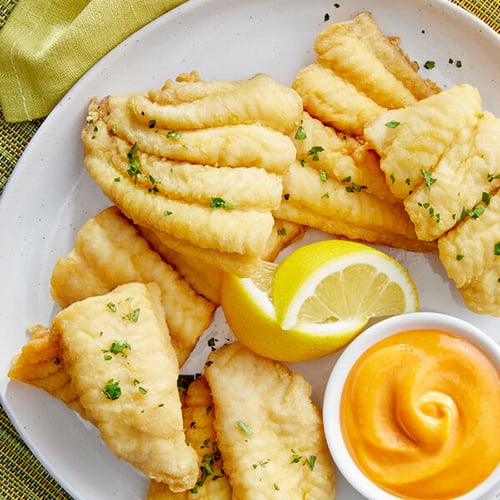The ideal temperature for deep-frying fish is between 350°F to 375°F. This range ensures a crispy exterior without overcooking the interior.
Cooking the perfect fish in a deep fryer is both an art and a science. Achieving that golden, crispy crust that gives way to perfectly cooked, flaky fish inside is the goal of any aspiring home chef or culinary professional.
The key to success lies in the temperature of the oil. Too low, and the fish will absorb excess oil, becoming greasy; too high, and it risks burning before it’s fully cooked. Maintaining a consistent temperature between 350°F and 375°F allows the fish to cook evenly, creating a delicious meal every time. It’s crucial to use a thermometer to monitor the oil’s temperature and adjust the fryer as needed to maintain that sweet spot for the ultimate deep-fried fish experience.
Table of Contents
The Heat Factor
The Heat Factor plays a crucial role in deep-frying fish. The right temperature ensures a crispy outside and a tender inside. Mastering this can turn a simple fish fillet into a mouthwatering delight.
Optimal Temperature Range
Finding the sweet spot for temperature is key. Generally, 350°F to 375°F (175°C to 190°C) is ideal for most fish. This range cooks the fish quickly without absorbing too much oil.
Types Of Fish And Temperature Variations
Different fish types may require slight adjustments in temperature.
- Thin fillets like tilapia thrive around 350°F.
- Thicker cuts, such as halibut, do well up to 375°F.
Using a thermometer helps maintain the right temperature for perfect fish every time.
Deep Fryer Dynamics
Let’s dive into Deep Fryer Dynamics. This part is key for perfect fish. Deep fryers make cooking fish quick and tasty. Yet, knowing the best temperature is crucial. Let’s explore this.
Understanding Thermostat Controls
Every deep fryer has a thermostat. It lets you set the heat. For fish, the magic number is between 350°F to 375°F. This range makes the fish crispy outside and soft inside. Not all fryers show accurate temperatures. It’s smart to use a separate thermometer. This ensures the oil is just right.
Importance Of Consistent Heat
Keeping the heat steady is a must. It cooks the fish evenly. If the temperature drops, the fish soaks up oil. It becomes greasy. If too hot, the outside burns before the inside cooks. A steady 350°F to 375°F is your goal. This gives you golden, delicious fish every time.
- Check the fryer’s temperature often.
- Use a kitchen thermometer for accuracy.
- Avoid adding too much fish at once. It lowers the temperature.
Remember, the right temperature makes all the difference. Follow these tips for the best fish fry!
Preparation For Perfection
Preparation for Perfection starts with understanding the nuances of cooking fish. Achieving a crispy, golden exterior with a perfectly cooked interior is an art form. The right temperature in your deep fryer is crucial. Follow these steps to ensure your fish turns out delicious every time.
Choosing The Right Oil
Not all oils are created equal when it comes to deep frying. The best oils have high smoke points. This means they can handle the heat without burning. Here are some top choices:
- Peanut oil: Offers a neutral taste and can reach high temperatures.
- Canola oil: Another neutral option that’s also budget-friendly.
- Vegetable oil: A blend of oils that resists high cooking temperatures.
Fish Preparation Techniques
Proper fish preparation ensures a better fry. Start with these steps:
- Clean: Rinse the fish in cold water and pat dry.
- Season: Apply your favorite spices for flavor.
- Batter: Coat evenly for a crispy shell.
- Rest: Let the fish sit for a few minutes to set the batter.
Remember to keep the fish in a single layer. This prevents sticking and uneven cooking. Now you’re ready to fry to perfection!
Cooking Time Considerations
Mastering the art of deep-frying fish is all about timing. The right temperature and cooking duration ensure a crispy exterior and a perfectly cooked interior. Let’s explore how size, thickness, and visual cues can guide us to achieve that ideal fish fry.
Size And Thickness Impact
Fish size and thickness directly affect cooking time. A thicker cut requires more time, while smaller pieces cook faster. Aim for consistent thickness to ensure even cooking.
| Fish Size | Approximate Cooking Time |
|---|---|
| Small & Thin (1/2 inch) | 3-4 minutes |
| Medium (1 inch) | 5-7 minutes |
| Large & Thick (1.5 inches and up) | 8-10 minutes |
Visual And Textural Cues
Look for a golden-brown color as a sign of doneness. The fish should feel firm to the touch. It should also flake easily with a fork. These signs indicate your fish is ready to leave the fryer.
- Golden-brown color
- Firm texture
- Flakes easily
Breading And Batter Secrets
Let’s dive into the world of breading and batter secrets for frying fish. A perfect crust makes fried fish unforgettable. Here, we will uncover how to achieve that golden crunch and infuse flavors that excite the taste buds.
Achieving The Golden Crunch
For that irresistible crunch, the right breading technique is key. Start with dry fish. Pat it dry with paper towels. Mix flour with a pinch of salt and pepper. Dip your fish in this mix. Next, dunk the fish into beaten eggs. Finally, coat it with breadcrumbs or panko. This triple-dip method ensures a crispy outer layer that’s hard to resist.
- Flour – It helps the batter stick to the fish.
- Eggs – They bind the flour and final coating.
- Breadcrumbs or Panko – They give that golden crunch.
Flavor Infusion Tips
To make your fried fish memorable, infuse flavors into the breading or batter. Add spices and herbs to the flour mix. Think paprika, garlic powder, or dried thyme. These add depth to the fish’s flavor.
- Mix spices with flour before the first coating.
- Experiment with different herbs and spices.
- For a zestier taste, add lemon zest to the breadcrumb mix.
Remember, the best fried fish combines a golden crunch with mouth-watering flavors. Use these tips to elevate your next fish fry.
Safety Measures
Safety Measures are key when deep frying fish. A delicious outcome requires careful attention. Accidents can occur without proper precautions. Let’s explore how to fry safely.
Avoiding Oil Splatters
Hot oil can burn skin. Keep a clean, dry workspace to prevent splatters. Use tools designed for deep frying. They help you lower food gently into the fryer. This reduces splashes.
- Pat fish dry before frying to minimize oil reaction.
- Use a fry basket to lower pieces smoothly into oil.
- Never overfill the fryer. It causes oil to spill over.
Managing Cooking Temperatures
Correct temperatures ensure safety and perfect fish. A thermometer is your best tool here. It helps you maintain the right heat. Fish cooks well between 350°F and 375°F.
| Fish Type | Temperature | Time |
|---|---|---|
| Cod | 365°F | 5-7 min |
| Salmon | 375°F | 6-9 min |
Monitor the oil temperature regularly. Adjust the fryer settings to keep it stable. Always heat oil slowly. Sudden changes can cause oil to ignite.
Troubleshooting Common Issues
Frying fish requires skill and understanding of temperature control. Even seasoned cooks sometimes face issues. Let’s troubleshoot common problems when deep frying fish.
Dealing With Oil Temperature Fluctuations
Maintaining the right oil temperature is crucial for perfect fish. Here are some tips:
- Use a deep-fry thermometer to monitor oil temperature.
- Adjust the heat if the temperature rises or falls.
- Avoid adding too many fish pieces at once; it cools the oil quickly.
- Let the oil return to the correct temperature between batches.
Preventing Soggy Or Overcooked Fish
To prevent soggy or overcooked fish, follow these steps:
| Issue | Solution |
|---|---|
| Soggy Fish | Ensure oil is hot enough before adding fish. |
| Overcooked Fish | Cook in small batches and check frequently. |
Pat fish dry before frying to prevent moisture.
Use a timer to avoid overcooking.
Drain on paper towels after frying.

Credit: www.youtube.com
Serving And Presentation
The perfect deep-fried fish doesn’t end at cooking. Serving and Presentation matter too. Let’s make your fish dish a feast for the eyes and the palate.
Complementing Sides And Sauces
Choosing the right sides and sauces can elevate your fish. Here are some ideas:
- French Fries: A classic pair for fried fish.
- Coleslaw: Adds a crunchy, fresh contrast.
- Tartar Sauce: Creamy with a tangy kick.
- Lemon Wedges: A simple squeeze brightens flavors.
Experiment with different combinations to find your favorite.
Plating Techniques For Appeal
Plating is crucial for that ‘wow’ factor. Follow these tips:
- Use a white plate for a clean background.
- Place the fish off-center for a modern look.
- Add color with sides and garnishes.
- Drizzle sauce artfully around the dish.
Remember, the goal is to tempt the eyes and then the taste buds.
Sustainable And Healthy Frying

Credit: www.webstaurantstore.com
Advanced Techniques
Frying fish requires skill and the right techniques. Getting the temperature just right is crucial. Let’s dive into some advanced methods for perfect fried fish every time.
Exploring Different Batters
The batter is key to a crispy, delicious coating. Different types of batter can affect the taste and texture of your fried fish. Here are some popular options:
- Beer Batter: It makes fish light and crispy.
- Tempura: Offers a delicate crunch and golden color.
- Cornmeal Batter: Provides a hearty, textured bite.
Try these batters at 350-375°F for the best results. Always check the internal temperature of the fish reaches 145°F.
Mastering The Double Fry Method
The double fry method ensures extra crispiness. Here’s how to do it:
- Fry the fish at 325°F until it’s cooked through.
- Let it cool slightly on a wire rack.
- Re-fry at 375°F for a golden, crispy exterior.
This technique locks in moisture and creates a satisfying crunch. Remember to let the fish rest between fries. It prevents it from becoming greasy.

Credit: onthewater.com
Frequently Asked Questions
What Temperature Do You Fry Fish At In A Deep Fryer?
For deep frying fish, maintain the oil temperature at 350-375 degrees Fahrenheit (175-190 degrees Celsius).
Is It Better To Fry Fish At 350 Or 375?
For crispy results, frying fish at 375 degrees Fahrenheit is recommended over 350. Higher temperatures cook the batter swiftly, sealing in juiciness.
How Long To Fry Fish At 350 In Oil?
Fry fish at 350°F in oil for about 3-5 minutes per side, until golden and cooked through. Always ensure the internal temperature reaches 145°F.
How Do You Know When Deep Fried Fish Is Done?
Deep-fried fish is done when it has a golden-brown color, floats to the surface, and its internal temperature reaches 145°F.
Conclusion
Achieving crispy perfection with fish in a deep fryer is all about temperature precision. Aim for 375°F to ensure a golden crust without compromising moisture. Experimentation might be key to personal taste, but this guideline offers a solid starting point.
So, heat up that fryer and get ready for a delicious, seafood feast!

